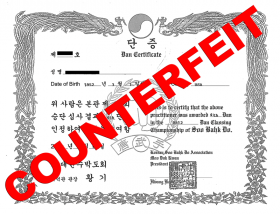Trademark Counterfeiting
The Lanham Act, The Trademark Act of 1984 and the Anticounterfeiting Consumer Protection Act of 1996 are Federal laws that address the growing issue of trademark counterfeiting.
Consumers who have been induced to enroll at a martial art studio when misrepresentation of material fact was present as a result of trademark infringement or trademark counterfeiting may have grounds for legal recourse against the infringer or counterfeiter unless complicit in this illegal act.
- Trademark counterfeiting violates federal statutes 15 U.S.C. § 1114, 1116, 1117, 1127, 18 U.S.C. § 2320 and is an act punishable up to a felony federal criminal offense. Trademark counterfeiters affix spurious marks or registered trademarks to products or services without a license from the registered trademark owner or copyright owner and produce and/or distribute their products, services or content in a dishonest manner calculated for their advantage by representing they are the source for things which they are not.
- Trademark counterfeiting conspiracy is trafficing in trademark counterfeits by multiple parties in violation of federal statutes 18 U.S.C § 371, 2318 & 2320 and is an act punishable as a federal criminal felony offense for all involved parties. Trademark counterfeiting conspiracy is present when multiple parties such as martial art vendors or instructors at different schools traffic in trademark counterfeit items, such as patches, flags, banners, rank certificates, etc.
A person who is charged with Trademark Counterfeiting may have committed the following acts:
- defendant knew that the trademark use was unauthorized and willfully created a counterfeit;
- defendant used the counterfeited trademark in connection with goods or services;
- defendant trafficked or attempted to intentionally traffic the counterfeit merchandise.
What penalties can one be facing if convicted of Trademark Counterfeiting?
The criminal penalties may depend on the scope of the Trademark Counterfeiting and the punishment may depend on the particular charges and varies case to case, but in many instances, trademark counterfeiters face prison sentences and the confiscation of all the counterfeit goods.
Identifying Counterfeits
Exhibits 1 -4 illustrate that it may be difficult to tell that an item is a counterfeit when casually looking at it and that is why it is important to conduct some personal due diligence to avoid being defrauded:
- Identity the legal martial art school name, martial art system name and/or martial art school/system logo
- Identify any registered trademarks or logos that you see displayed by the business
- Identify any registered trademarks or logos that you see displayed by the business
- Verify who owns the registered trademark or logos that you see displayed
- Verify that the business is licensed by the trademark owner to use the trademarks or logos you have identified
| Exhibit 1 | ||
|
Example Counterfeit Patches |
||
 |
 |
|
| Exhibit 2 | ||
|
Example Legitimate Patches |
||
 |
 |
 |
| Exhibit 3 | ||
|
Example Counterfeit Certificate |
||
 |
||
| Exhibit 4 | ||
|
Example Legitimate Certificate |
||
 |
||
Martial Arts Fraud's website provides information intended to help you proactively 1) recognize and identify circumstances with a high potential for you to become a victim of fraud, 2) verify factual evidence of fraud and 3) report evidence of fraud to appropriate agencies and authorities. Disclaimer
Leave a Reply
You must be logged in to post a comment.